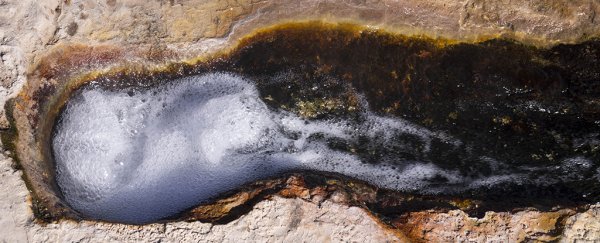We know that bacteria are incredibly stubborn microorganisms, and new research suggests they're also capable of travelling thousands of miles through the air. As you can imagine, this finding has implications for the spread of antibiotic resistance.
It was previously thought that germs needed to hitch a ride on people and animals to make their way around the world, but it seems they're capable of spreading long distances through the air all on their own.
To reach these conclusions, scientists studied the 'memories' logged in bacterial DNA – records left behind by encounters that the bacteria had had with viruses (bacteriophages) in the past. The question is, how those virus records got to where they did.
"Our research suggests that there must be a planet-wide mechanism that ensures the exchange of bacteria between faraway places," says senior researcher, molecular biochemist Konstantin Severinov from Rutgers University in New Jersey.
 A hot spring in the El Tatio, Chile. (Yaroslav Ispolatov)
A hot spring in the El Tatio, Chile. (Yaroslav Ispolatov)
The gene records the team looked at were found in the heat-loving Thermus thermophilus bacteria. The researchers took samples from hot gravel and hot springs at five different sites in Italy, Chile and Russia, including Mount Vesuvius.
Virus or bacteriophage infection gets remembered because the surviving cells pass the viral DNA on to the next generation, in regions called CRISPR arrays. As a result, scientists can track the way bacteria have interacted with viruses over time.
It's a form of self-defence: by snipping samples of the viruses as they're encountered, bacteria can better resist them next time around.
The team of researchers found that some of these pieces of viral DNA were similar across all these disparate sites, thousands of miles apart. It looks as though at least some strains of T. thermophilus have made their way across vast, intercontinental distances - but they didn't get any help from other living beings.
"Because the bacteria we study live in very hot water – about 160 degrees Fahrenheit [71 degrees Celsius] – in remote places, it is not feasible to imagine that animals, birds or humans transport them," says Severinov.
"They must be transported by air and this movement must be very extensive so bacteria in isolated places share common characteristics."
Exactly how the bacteria are getting around remains to be seen, but previous research has found that microorganisms found in sneezes can travel short distances by resisting the biological decay that would normally kill them off outside a host's body.
For now this idea of long-distance air travel remains a hypothesis that fits these findings. Next up, the team wants to analyse air samples taken at different altitudes and locations around the world, using planes, drones and research balloons. This will allow for comparison between groups of bacteria and their histories.
Ultimately it should give us a better idea of how bacteria – and antibiotic resistance – spreads around the world, and that puts us in a better position to manage it.
"Our analysis may inform ecological and epidemiological studies of harmful bacteria that globally share antibiotic resistance genes and may also get dispersed by air instead of human travellers," says Severinov.
The research has been published in Philosophical Transactions of the Royal Society B.
